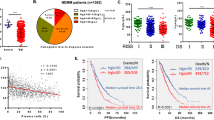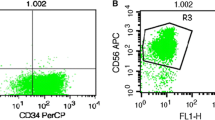Abstract
Multiple myeloma (MM) is a malignant disease of plasma cells and is often accompanied by anemia which may influence its progression and survival. The mechanism of anemia of chronic disease (ACD) in which iron homeostasis is impaired underlies that of MM-related anemia. In this study, we analyzed the role of hepcidin which is the main mediator of ACD and ACD-related cytokines in peripheral blood of MM patients. We showed that HAMP mRNA and growth differentiation factors 15 (GDF15) mRNA expressions in peripheral blood mononuclear cells (PBMCs) and plasma hepcidin, GDF15, interleukin-6 and erythropoietin in MM patients all increased significantly as compared to those in controls. In MM patients, the expression of HAMP mRNA showed a positive correlation with serum ferritin level, and a negative correlation with hemoglobin level. The levels of plasma hepcidin and GDF15 were significantly decreased in MM patients who achieved complete remission after six cycles VD (bortezomib + dexamethasone) regimen chemotherapy. These data indicated that overexpression of HAMP mRNA in PBMCs significantly correlated with increased plasma hepcidin level and may be involved in the pathogenesis of MM-related anemia. Furthermore, the levels of plasma hepcidin and GDF15 may be valuable in assessing the progress of MM.





Similar content being viewed by others
References
Robert A, Kyleand S, Rajkumar V, et al. Multiple myeloma. Blood. 2008;111:2962–72.
Caravita T, Siniscalchi A, Montanaro M, et al. High-dose epoetin alfa as induction treatment for severe anemia in multiple myeloma patients. Int J Hematol. 2009;90:270–2.
Cucuianu A, Patiu M, Rusu A. Hepcidin and multiple myeloma related anemia. Med Hypotheses. 2006;66:352–4.
Mittelman M. The implications of anemia in multiple myeloma. Clin Lymphoma. 2003;4(Suppl 1):S23–9.
Silvestris F, Tucci M, Quatraro C, et al. Recent advances in understanding the pathogenesis of anemia in multiple myeloma. Int J Hematol. 2003;78:121–5.
Goodnough LT. Erythropoietin and iron-restricted erythropoiesis. Exp Hematol. 2007;35:167–72.
Tanno T, Bhanu NV, Oneal PA, et al. High levels of GDF15 in thalassemia suppress expression of the iron regulatory protein hepcidin. Nat Med. 2007;13:1096–101.
Liu X, Xie W, Liu P, et al. Mechanism of the cardioprotection of rhEPO pretreatment on suppressing the inflammatory response in ischemia–reperfusion. Life Sci. 2006;78:2255–64.
Peyssonnaux C, Zinkernagel AS, Datta V, et al. TLR4-dependent hepcidin expression by myeloid cells in response to bacterial pathogens. Blood. 2006;107:3727–32.
Theurl I, Theurl M, Seifert M, et al. Autocrine formation of hepcidin induces iron retention in human monocytes. Blood. 2008;111:2392–9.
Ganz T, Olbina G, Girelli D, et al. Immunoassay for human serum hepcidin. Blood. 2008;112:4292–7.
Sharma S, Nemeth E, Chen YH, et al. Involvement of hepcidin in the anemia of multiple myeloma. Clin Cancer Res. 2008;14:3262–7.
Birgegård G, Gascon P, Ludwig H. Evaluation of anaemia in patients with multiple myeloma and lymphoma: findings of the European CANCER ANAEMIA SURVEY. Eur J Haematol. 2006;77:378–86.
Nemeth E, Valore EV, Territo M, et al. Hepcidin, a putative mediator of anemia of inflammation, is a type II acute phase protein. Blood. 2003;101:2461–3.
Nemeth E, Rivera S, Gabayan V, et al. IL-6 mediates hypoferremia of inflammation by inducing the synthesis of the iron regulatory hormone hepcidin. J Clin Investig. 2004;113:1271–6.
Truksa J, Peng H, Lee P, Beutler E. Different regulatory elements are required for response of hepcidin to interleukin-6 and bone morphogenetic proteins 4 and 9. Br J Haematol. 2007;139:138–47.
Maes K, Nemeth E, Roodman GD, et al. In anemia of multiple myeloma, hepcidin is induced by increased bone morphogenetic protein 2. Blood. 2010;116:3635–44.
Kautz L, Meynard D, Monnier A, et al. Iron regulates phosphorylation of Smad1/5/8 and gene expression of Bmp6, Smad7, Id1, and Atoh8 in the mouse liver. Blood. 2008;112:1503–9.
Meynard D, Kautz L, Darnaud V, et al. Lack of the bone morphogenetic protein BMP6 induces massive iron overload. Nat Genet. 2009;41:478–81.
Andriopoulos B, Corradini E, Xia Y, et al. BMP6 is a key endogenous regulator of hepcidin expression and iron metabolism. Nat Genet. 2009;41:482–7.
Katodritou E, Ganz T, Terpos E, et al. Sequential evaluation of serum hepcidin in anemic myeloma patients: study of correlations with myeloma treatment, disease variables, and anemia response. Am J Hematol. 2009;84:524–6.
Wrighting DM, Andrews NC. Interleukin-6 induces hepcidin expression through STAT3. Blood. 2006;108:3204–9.
Tarkun P, Birtas Atesoglu E, Mehtap O, et al. Serum growth differentiation factor 15 levels in newly diagnosed multiple myeloma patients. Acta Haematol. 2013;131:173–8.
Corre J, Labat E, Espagnolle N, et al. Bioactivity and prognostic significance of growth differentiation factor GDF15 secreted by bone marrow mesenchymal stem cells in multiple myeloma. Cancer Res. 2012;72:1395–406.
Tanno T, Lim Y, Wang Q, et al. Growth differentiating factor 15 enhances the tumor-initiating and self-renewal potential of multiple myeloma cells. Blood. 2014;123:725–33.
Tamary H, Shalev H, Perez-Avraham G. Elevated growth differentiation factor 15 expression in patients with congenital dyserythropoietic anemia type I. Blood. 2008;112:5241–4.
Aizawa S, Harada T, Kanbe E, et al. Ineffective erythropoiesis in mutant mice with deficient pyruvate kinase activity. Exp Hematol. 2005;33:1292–8.
Kempf T, Horn-Wichmann R, Brabant G, et al. Circulating concentrations of growth-differentiation factor 15 in apparently healthy elderly individuals and patients with chronic heart failure as assessed by a new immunoradiometric sandwich assay. Clin Chem. 2007;53:284–91.
Akiyama M, Okano K, Fukada Y, et al. Macrophage inhibitory cytokine MIC-1 is upregulated by short-wavelength light in cultured normal human dermal fibroblasts. FEBS Lett. 2009;583:933–7.
Ago T, Kuroda J, Pain J, et al. Upregulation of Nox4 by hypertrophic stimuli promotes apoptosis and mitochondrial dysfunction in cardiac myocytes. Circ Res. 2010;106:1253–64.
Léon K, Grace J, Elizabeta N, et al. The erythroid factor erythroferrone and its role in iron homeostasis. Blood. 2013;122:21–4.
Acknowledgments
This project was supported by the anticancer major special project of Tianjin (12ZCDZSY17900, 12ZCDZSY18000) and Medical Association of Multiple Myeloma Foundation Project (20090901).
Conflict of interest
None.
Author information
Authors and Affiliations
Corresponding author
About this article
Cite this article
Mei, S., Wang, H., Fu, R. et al. Hepcidin and GDF15 in anemia of multiple myeloma. Int J Hematol 100, 266–273 (2014). https://doi.org/10.1007/s12185-014-1626-7
Received:
Revised:
Accepted:
Published:
Issue Date:
DOI: https://doi.org/10.1007/s12185-014-1626-7




